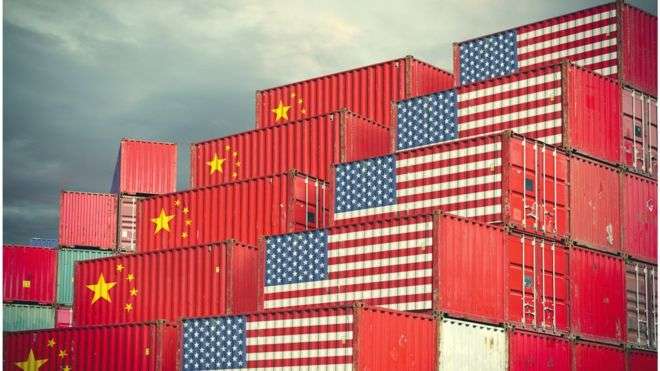The US started imposing tariffs on $200bn ($152bn) worth of Chinese products from 12:01 Beijing time (04:01 GMT), in response to what it says are unfair trading practices by China.
China retaliated by targeting $60bn of US goods with extra duties.
It says the US has started the "largest trade war in economic history".
The latest move takes the total amount of Chinese imports hit by US tariffs since July up to $250bn. This means about half of all Chinese imports to the US are now subject to these new duties.
What is happening on Monday?
US companies importing the Chinese products in question will have to pay an additional 10% levy.
The US duties apply to almost 6,000 items, making them the biggest round of trade tariffs yet from Washington.
They affect handbags, rice and textiles, although some items such as smart watches and high chairs have been exempted.
The tax will rise to 25% from the start of 2019, unless the two countries agree a deal.
In contrast, China is placing an additional 5% in duty on US products including smaller aircraft, computers and textiles, and an extra 10% on goods such as chemicals, meat, wheat and wine.
The tariffs to date
In total, the US has imposed three rounds of tariffs on Chinese products this year, totalling $250bn worth of goods.
It placed 25% tariffs on $50bn worth of imports from China in two separate rounds.
In July, the White House increased charges on $34bn worth of Chinese products.
Then last month, the escalating trade war moved up a gear when the US brought in a 25% tax on a second wave of goods worth $16bn.
Beijing retaliated in kind.
China has imposed duties on $50bn of US products in retaliation, targeting key parts of the president's political base, such as farmers.
Why is the US doing this?
President Donald Trump says he wants to stop the "unfair transfers of American technology and intellectual property to China" and protect jobs.
Tariffs, in theory, will make US-made products cheaper than imported ones, so encourage consumers to buy American. The idea is they would boost local businesses and support the national economy.
But many US companies and industry groups have testified to the US Trade Representative's Office that their businesses are being harmed.
There are signs that companies and economies are already being affected, and the IMF has warned major escalations will hit global growth.
Mr Trump's tariff policies are part of his protectionist trade agenda since taking office, which challenges decades of a global free trade system.
What comes next?
Mr Trump recently said taxes on another $267bn of goods were "ready to go on short notice" - that would mean virtually all of China's exports to the US would be subject to new duties.
It is unclear how China can match the scale of US tariffs longer term.
The US buys far more from China than it sells to them, so China only has limited room to retaliate through trade.
Analysts have said China could get creative when fighting back.
It could make life more difficult for American companies in China or force its currency lower to boost exports.
Mr Trump recently accused China of doing just that. But China has hit back at these accusations.
China "will never go down the path of stimulating exports by devaluating its currency", Premier Li Keqiang said last week.
BBC
More about: US-Chinatrade
















































